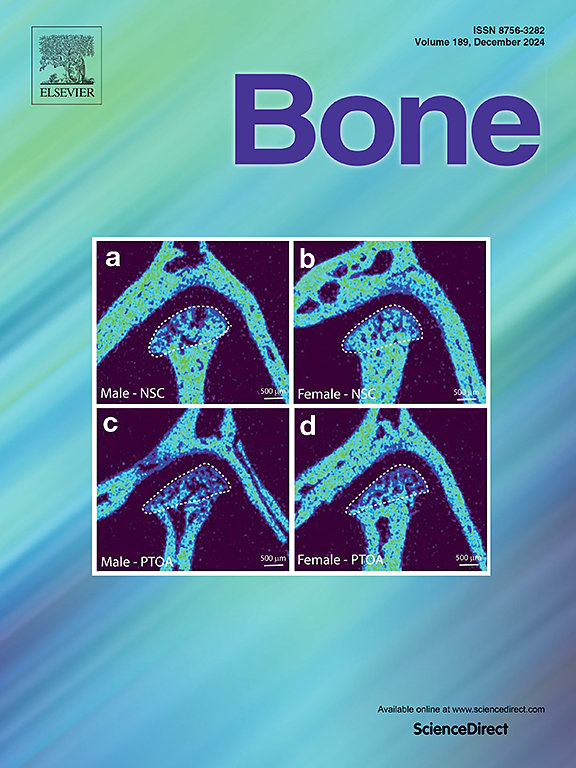如何鉴别脑瘫患儿低骨密度风险
IF 3.6
2区 医学
Q2 ENDOCRINOLOGY & METABOLISM
引用次数: 0
摘要
脑性麻痹是儿童中一种常见的慢性运动障碍。本研究的目的是确定脑瘫儿童低骨密度(BMD)的患病率,并检查骨密度与危险因素之间的关系。方法对脑瘫儿童进行横断面研究,分析双x线吸收测量、血液检查、Tanner分期和营养状况、人体测量和身体活动评估等临床医学检查。结果81例患者年龄2.1 ~ 17.4岁(中位9岁),其中64例患有轻度脑瘫(大运动功能分类系统评分为I-II)。平均BMD z-score为- 0.2 (SD = 1.05,范围- 4.6 ~ 2.0)。GMFCS评分与BMD呈负相关(p <;0.01),分数越高,骨密度越低(1.43 SD)[- 1.97 ~ - 0.89]。负重活动与较低的BMD z-score呈负相关(p = 0.01),因为每天有30分钟的负重活动导致BMD降低0.98 SD [- 1.75;−0.22]。抗癫痫药物的使用与BMD呈负相关(BMD z-score低0.7 SD;P = 0.02,[−1.28;−0.12])。血清维生素D水平或骨折率与骨密度变化无统计学意义。结论无论运动障碍程度如何,17%的儿童存在低骨密度。GMFCS评分、稀疏负重活动和抗癫痫药物的使用与BMD呈负相关。与维生素D、性别、身体质量指数、青春期没有明显的联系。本文章由计算机程序翻译,如有差异,请以英文原文为准。

How to identify children with cerebral palsy at risk of low bone mineral density
Aim
Cerebral palsy is a common chronic motorically disabling condition in children. The aim of this study was to determine prevalence of low bone mineral density (BMD) in children with cerebral palsy and to examine the association between BMD with risk factors.
Methods
Cross sectional study of children with cerebral palsy analyzing Dual X-ray Absorptiometry, blood tests, full clinical medical examination including Tanner stage and nutritional status, measurement of anthropometrics and assessment of physical activity.
Results
The 81 participants were aged 2.1–17.4 years (median 9 years) and 64 out of 81 had a mild cerebral palsy (Gross Motor Function Classification System score of I-II). Mean BMD z-score was −0.2 (SD = 1.05, range −4.6 to 2.0). GMFCS score was negatively associated with BMD (p < 0.01) as higher score led to 1.43 SD lower BMD [−1.97 to −0.89]. Weight bearing activity was negatively associated with lower BMD z-score (p = 0.01), as having <30 min of weight bearing activity per day lead to 0.98 SD lower BMD [−1.75; −0.22]. Use of anti-seizure medication was negatively associated with BMD (BMD z-score 0.7 SD lower; p = 0.02, [−1.28; −0.12]). Serum vitamin D levels or fracture rates were not statistically significantly associated with BMD changes.
Conclusion
We found 17 % of children have low BMD regardless of motoric impairment level. GMFCS score, Sparse weight bearing activity and use of anti-seizure medicine were negatively associated to BMD. No significant associations were found with vitamin D, sex, BMI, puberty.
求助全文
通过发布文献求助,成功后即可免费获取论文全文。
去求助
来源期刊

Bone
医学-内分泌学与代谢
CiteScore
8.90
自引率
4.90%
发文量
264
审稿时长
30 days
期刊介绍:
BONE is an interdisciplinary forum for the rapid publication of original articles and reviews on basic, translational, and clinical aspects of bone and mineral metabolism. The Journal also encourages submissions related to interactions of bone with other organ systems, including cartilage, endocrine, muscle, fat, neural, vascular, gastrointestinal, hematopoietic, and immune systems. Particular attention is placed on the application of experimental studies to clinical practice.
 求助内容:
求助内容: 应助结果提醒方式:
应助结果提醒方式:


